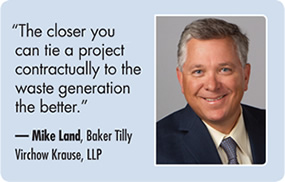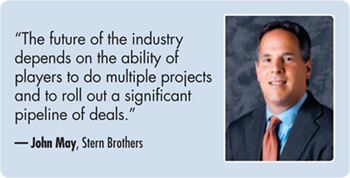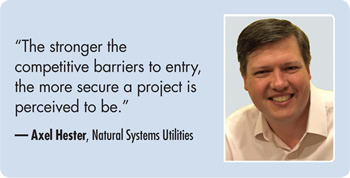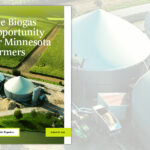Recent American Biogas Council webinar focused on tools and strategies to raise capital for anaerobic digestion facilities targeting food waste feedstocks.
Marsha Johnston
BioCycle May 2015
Designing food and organic waste diversion projects that are sufficiently large and easily replicated, with secured feedstocks and off-take contracts, is key to attracting capital for anaerobic digestion (AD) projects, said four renewable energy finance experts in a webinar, “Reinventing Biogas Finance,” organized by the American Biogas Council (ABC) in early April.
Selling financiers on ideas new to capital markets, as AD biogas projects are in the U.S., is often difficult, noted Mike Land, director at Baker Tilly Virchow Krause, LLP and cochair of ABC’s Finance Working Group, in introducing the session. But, he continued, biogas projects’ marketability is helped somewhat in that people can intuitively understand that harvesting the energy locked in food and organic waste is more efficient than putting it in a landfill. In addition, AD biogas projects often provide positive impacts such as job retention in rural settings and add-on projects with potential revenue.
At the same time, added Land, the tendency of food waste biogas projects to be large —between $15 and $50 million — and disruptive to the existing waste management order, often requires greater planning and multiple funding parties.
Small AD or biogas projects of less than $15 million are often funded with tax-exempt bonds, and buyers of those bonds could be willing to consider those projects, explained John May, managing director at Stern Brothers. However, he added, unless such small projects have a municipal characteristic or public-private partnership approach, they can be difficult to finance. “Most muni bond buyers will not look at tax-exempt, private developer-driven activity bonds of small size because the credit comes from the developer and counterparties to the contracts and not the municipality,” he said.
Overall, noted Axel Hester, executive vice president of investment management for Natural Systems Utilities, investors view biogas projects as inherently riskier than solar or wind energy projects because they are more customized to a specific location, and thus less replicable and lacking a reliable track record of performance. With the local focus, they also lack standard regulations, he continued, and their longer duration means the projects have no proven market to provide liquidity and no reliable exit strategy. “Longer duration” refers to a customary investment time frame for investors of 5 to 10 years while biogas projects generally have 15 to 20+ year durations without a defined early exit strategy. Finally, Axel said, biogas project assets are often immobile and have relatively low collateral value.
 Furthermore, biogas project developers often structure their projects without paying attention to the elements that will attract capital. “Very often, the cash flow the project is structured to generate is not high enough to cover the debt service and provide adequate equity returns,” explained May, adding that they instead focus on selecting a location and technology, and looking at the supply chain, such as tipping fees, electricity rates or, in rare instances, carbon credits. Digester projects in the U.S. that are selling carbon credits have so far been limited to projects using livestock manure, not food waste, as feedstock, per the protocols established by the California Air Resources Board (CARB), added Land.
Furthermore, biogas project developers often structure their projects without paying attention to the elements that will attract capital. “Very often, the cash flow the project is structured to generate is not high enough to cover the debt service and provide adequate equity returns,” explained May, adding that they instead focus on selecting a location and technology, and looking at the supply chain, such as tipping fees, electricity rates or, in rare instances, carbon credits. Digester projects in the U.S. that are selling carbon credits have so far been limited to projects using livestock manure, not food waste, as feedstock, per the protocols established by the California Air Resources Board (CARB), added Land.
Mitigating Risks
Consequently, developers must mitigate the financial risks by securing as many as possible of both the cash flow and non-cash flow aspects of a project, including significant variable operating costs, by contracting with credit-worthy partners. On the cash flow side, developers need contracts for the volume, price and duration of feedstock supplies, energy and product off-takes such as compost, and production incentives, e.g., Renewable Identification Numbers (RIN) and Renewable Energy Certificates (REC), Hester explained. The latter could include natural gas or chemicals, for which a developer could secure long-term pricing. “If you secure the feedstock, but not the price, you have not secured it from the investor point of view,” he said, adding that quality standards or specifications can be added to a feedstock contract.
Land concurred, saying it is good for a digester to contract with a grocery store chain, food processor, or a group of restaurants that generate the waste. “The closer you can tie a project contractually to the waste generation the better,” he said. He added that contracting with a waste hauler for a feedstock it gets from particular generator is riskier because if the hauler loses control of the waste stream it will likely not be able to make good on the contract with the digester facility.
On the non-cash flow side, Hester explained, developers should secure contract commitments for technology performance guarantees, site access (leases, easements), right-of-use permits and construction delivery schedules and pricing.
Land noted how investors view three primary types of food waste/organics diversion projects — food and beverage industry by-products, commercial organic waste and municipal organic waste. The more homogenous consistency regarding make up of food and beverage industry by-product feedstocks is considered positive for a project although it can be challenging to obtain suitable alternative material in the event contracted feedstock quantities fall short, he explained: 1) There may not be adequate alternative volume close enough to the AD facility to remain economically viable; 2) The alternative material may not have sufficient energy content; or 3) The alternative material may not work for the design of the facility without additional capital expenditures. Therefore, developers should try to identify specific alternative feedstock streams and their characteristics prior to approaching funding parties.
 Commercial organic waste, he added, has the most potential for tip fee revenue, but often requires a high level of investment in preprocessing equipment to handle contamination and variations in the waste. Finally, said Land, securing municipal organic waste from financially strong communities can enhance the feasibility of food waste projects.
Commercial organic waste, he added, has the most potential for tip fee revenue, but often requires a high level of investment in preprocessing equipment to handle contamination and variations in the waste. Finally, said Land, securing municipal organic waste from financially strong communities can enhance the feasibility of food waste projects.
On the flip side, said May, frequent problems with biogas projects are a low quality of targeted feedstock and a lack of creditworthiness in the party contracted to purchase the off-takes. Together, they create a project that is not strong enough to attract viable project financing, even if the “nominal economics might look good.”
Pooling Projects
May was most emphatic about the need for biogas facility developers to adopt strategies that will allow financiers to fund more than one project at a time, either by pooling projects or setting up a Development Corporation — a joint venture between the project developers and an equity partner that would provide an upfront commitment of equity to develop a series of projects on a bundled or sequential basis, depending on project readiness, within a defined pipeline. “I really think the future of the industry depends on the ability of players to do multiple projects and to roll out a significant pipeline of deals,” he explained. “The idea of pooling projects and financing more than one at a time seems to be of interest as I travel around the country.”
Pooled projects, May added, should be of similar size, preferably the same technology and the same feedstock and off-take counterparties. “The idea is to create the same credit quality in each project by having uniform credit characteristics across projects. If you want to attract capital, whether debt or equity, you have to give people reason to want to do more than one project.” If requirements for a pooling approach can be satisfied, developers will reap tremendous benefits, he said.
 With a Development Corporation strategy, the developer may still create special purpose vehicles, such as the Limited Liability Corporation, for individual projects without recourse to the parent company. May explained that such project companies are subsidiaries of the parent corporation that sit between parent and project level. “This allows the developer of a pipeline of projects to have more than one project generating cash flow, debt service and returning funds to upstream equity partners and the Joint Venture Development Corporation partners,” he said.
With a Development Corporation strategy, the developer may still create special purpose vehicles, such as the Limited Liability Corporation, for individual projects without recourse to the parent company. May explained that such project companies are subsidiaries of the parent corporation that sit between parent and project level. “This allows the developer of a pipeline of projects to have more than one project generating cash flow, debt service and returning funds to upstream equity partners and the Joint Venture Development Corporation partners,” he said.
When Earnings Before Interest, Tax, Depreciation and Amortization (EBITDA) reaches a level of $20 million, the Development Corporation can sell the specific pipeline of projects into a Yield Corporation or other tax-advantageous ownership structure, such as a Real Estate Investment Trust (REIT) or a Master Limited Partnership (MLP). A REIT is a mechanism approved for leasehold or mortgage interests associated with facilities that have sufficient real property aspects and generate long-term steady passive income streams. It can be used to raise public capital without double taxation of income at company and shareholder levels, based on land interests underlying properly structured renewable energy projects. Like a REIT, but with different mechanisms and requirements, an MLP can allow direct lower-cost access to public capital by selling partnership interests like stock shares.
Using one of those structures, said May, would allow for two liquidity events for the developer of the original project: 1) Take the Development Corporation project public at a multiple of cash flow; 2) Going public at the parent level, particularly where the technology has more uses than simply the conversion of waste to energy, but also allows the production of specialty products, chemicals etc.
Additional Tips
Other tips for securing project financing discussed on the webinar include:
Identify a buyer for the risk. Find a “natural buyer” for the risk, who has either the most experience managing the risk or manages an off-setting risk, such as an industrial partner with a natural gas feed-in. May noted that a Missouri developer, for example, found creditworthy strategic partners in one of the larger food companies in the U.S. for feedstock and in a large utility that will purchase electricity.
Act early. Get contracts or Expressions/Letters of Intent as early as possible. “In general, the further along a project, the less negotiating power the developer holds,” Hester said, explaining that the more money a developer has sunk into the project, the more he or she will be perceived as needing to get it done, giving the lender an advantage in dictating terms.
Leverage infrastructure. Leverage existing infrastructure for competitive advantage, such as co-locating with a water resource recovery facility that has underutilized digester capacity and securable sludge feedstock. Other examples of leveraging include locating close to gas or electricity off-take facilities, such as gas pipelines or large energy consumers, or to transportation corridors. “The stronger the competitive barriers to entry, the more secure a project is perceived to be,” Hester explained.
Keep it simple. Keep the capital structure simple in order to provide investors an exit. Tax credits, for example, while highly advantageous, complicate the capital structure, and should not be relied upon in initial evaluations.
Approach investors with nonfinancial interests. Developers who cannot secure funding from financiers may be able to find it from investors with nonfinancial motives, including governmental environment, industrial development or agricultural agencies or “impact” investors, which consider environmental and social, as well as financial, benefits, said Hester. Land agreed that aligning with public initiatives can make projects more financeable and that “green” banks can provide credit support sufficient to bridge funding support gaps.
Marsha Johnston, principal of Earth Steward Associates in Arlington, Virginia, is a Contributing Editor to BioCycle.












